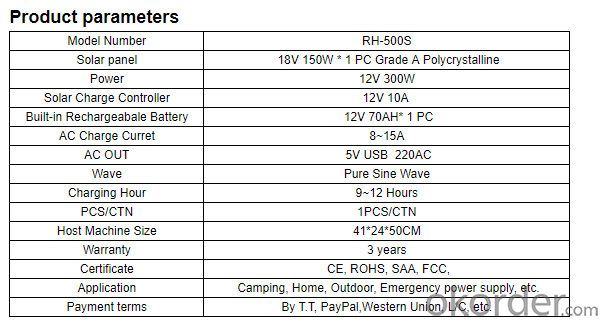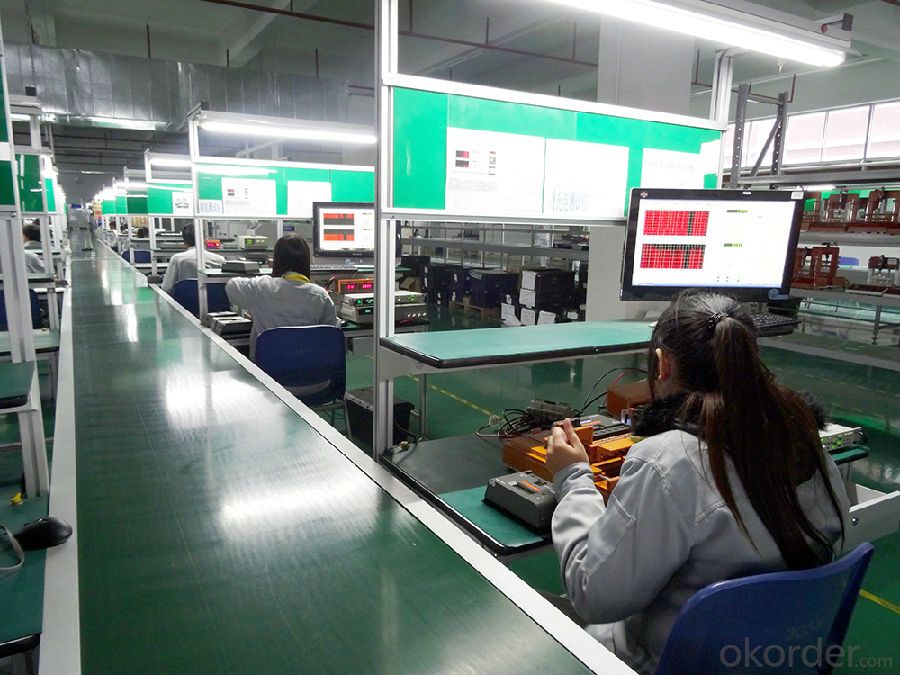oem ,odm ,500w, 1000w ,1500w lithium Portable home use solar energy system
- Loading Port:
- Shanghai
- Payment Terms:
- TT or LC
- Min Order Qty:
- 10 set
- Supply Capability:
- 5000 set/month
OKorder Service Pledge
OKorder Financial Service
You Might Also Like
Item specifice
This solar lighting system is ideal for places with no mains electricity such as outhouses, sheds, garages, farms, stables, as well as for camping, travel and any outdoor activities (e.g. a for a yurt).
The system is fully independent from the grid / AC power source and works purely based on sunlight energy.
During the daytime, the 12W solar panel charges a 12V battery inside the control unit, which then provides power to the 2 x 3W 12V LED lights connected via front sockets on the control unit.
In addition, there is a standard 5V USB socket for charging mobile phones and USB compatible devices (adaptors for USB-compatible mobile phones are included).
The control unit has a built-in 4Ah battery with an automatic solar charge controller to manage the charging process and prevent overcharging.
The 12W solar panel supplied with the system can fully charge this battery within about 7-8 hours of bright sunshine (longer in cloudy weather), and the battery can provide enough energy to power 2 LED lights continuously for 14 hours, or twice as long if only one LED lights are connected.
The system is very convenient to use and install: the solar panel comes with 5m cable and each LED light comes with 4m cable with an On/Off switch.


- Q:Can solar energy systems be used to power agricultural operations?
- Yes, solar energy systems can be used to power agricultural operations. Solar panels can generate electricity that can be used to power various agricultural equipment such as irrigation systems, water pumps, and machinery. This renewable energy source can provide a sustainable and cost-effective solution for powering farming operations while reducing reliance on fossil fuels.
- Q:What is the difference between a grid-tied and off-grid solar energy system?
- A grid-tied solar energy system connects to the local electricity grid, while an off-grid solar energy system operates independently and is not connected to the grid. In a grid-tied system, electricity is generated from the sun by solar panels and converted into usable AC power through an inverter. This power is used by the household or business where the system is installed. If the solar panels produce more electricity than is consumed, the excess power is sent back to the grid, resulting in possible credit or payment from the utility company. When the solar panels do not generate enough power, electricity is drawn from the grid, ensuring a continuous and reliable power supply with the grid serving as a backup. On the other hand, an off-grid solar energy system is designed to operate independently from the grid. It typically includes a battery bank to store surplus electricity generated by the solar panels. This stored power can be used when the panels do not produce enough. An inverter is also required to convert the solar panels' DC power into usable AC power. Off-grid systems are commonly used in remote areas where connecting to the grid is expensive or impractical. The main difference between the two systems lies in their level of independence and connection to the grid. Grid-tied systems offer the advantage of selling excess electricity back to the utility company, potentially saving costs or generating revenue. They also provide a reliable power supply by using grid power when solar production is low. On the other hand, off-grid systems provide complete energy independence and do not rely on the grid. However, they require careful planning and sizing to ensure sufficient power availability at all times since there is no grid backup. Additionally, off-grid systems often necessitate more complex equipment, such as batteries, for storing and managing electricity.
- Q:Can solar energy systems be used in cold storage facilities?
- Yes, solar energy systems can be used in cold storage facilities. Solar panels can generate electricity to power the refrigeration systems required for cold storage. However, it is important to design the system with proper insulation and backup power options to ensure continuous operation during periods of low sunlight or high energy demand.
- Q:What are the different financing options for solar energy systems?
- There are several financing options available for solar energy systems. These include purchasing the system outright with cash or a loan, leasing the system, utilizing power purchase agreements (PPAs), and utilizing solar loans or solar-specific financing programs. Each option has its own benefits and considerations, such as upfront costs, ownership, maintenance responsibilities, and potential tax incentives. It is important to research and compare these options to determine the best fit for individual circumstances and financial goals.
- Q:Can solar energy systems be installed in areas with high snowfall?
- Yes, solar energy systems can be installed in areas with high snowfall. However, it is important to consider the impact of snow accumulation on the efficiency and performance of these systems. Proper design and installation techniques can help minimize the impact of snow on solar panels, such as tilted mounting angles, snow guards, and regular snow removal. Additionally, advancements in technology have led to the development of snow-shedding coatings and self-cleaning systems that can further enhance the productivity of solar energy systems in snowy regions.
- Q:Are there any limitations to the use of solar energy systems?
- Yes, there are limitations to the use of solar energy systems. Some of the limitations include the variability of sunlight availability depending on location and weather conditions, the initial high costs of installation and equipment, the need for sufficient space for installation, and the intermittent nature of solar power generation. Additionally, energy storage solutions are required to ensure a continuous power supply during nighttime or cloudy periods. However, advancements in technology and increasing affordability are helping to overcome these limitations and make solar energy systems more viable and widespread.
- Q:How do solar energy systems impact water resources?
- Solar energy systems have a minimal impact on water resources compared to other forms of energy production. Unlike traditional power plants that require large amounts of water for cooling, solar power generation does not consume water during operation. This reduces water stress, preserves aquatic ecosystems, and ensures the availability of clean water for other uses like agriculture and drinking. However, the manufacturing process of solar panels and other components might require water, but it is generally much lower compared to the water usage of conventional energy sources. Overall, solar energy systems contribute positively to water conservation and sustainability.
- Q:What is the lifespan of solar cells used in solar energy systems?
- The lifespan of solar cells used in solar energy systems can vary, but on average, they are designed to last for approximately 25 to 30 years.
- Q:What are the devices needed for PV systems?
- Battery pack. The utility model is used for storing the electric energy generated by the solar array when illuminated by the light and can supply power to the load at any time. In the grid connected solar power generation system, the battery can not be added
- Q:Can solar energy systems be used to power boats or yachts?
- Yes, solar energy systems can be used to power boats or yachts. Solar panels can be installed on the roof or deck of the boat or yacht to generate electricity from the sun. This energy can then be used to power the boat's electrical systems, including lights, navigation equipment, and even propulsion systems. Solar power is a sustainable and renewable energy source, making it an environmentally friendly option for powering boats and yachts.
1. Manufacturer Overview |
|
|---|---|
| Location | |
| Year Established | |
| Annual Output Value | |
| Main Markets | |
| Company Certifications | |
2. Manufacturer Certificates |
|
|---|---|
| a) Certification Name | |
| Range | |
| Reference | |
| Validity Period | |
3. Manufacturer Capability |
|
|---|---|
| a)Trade Capacity | |
| Nearest Port | |
| Export Percentage | |
| No.of Employees in Trade Department | |
| Language Spoken: | |
| b)Factory Information | |
| Factory Size: | |
| No. of Production Lines | |
| Contract Manufacturing | |
| Product Price Range | |
Send your message to us
oem ,odm ,500w, 1000w ,1500w lithium Portable home use solar energy system
- Loading Port:
- Shanghai
- Payment Terms:
- TT or LC
- Min Order Qty:
- 10 set
- Supply Capability:
- 5000 set/month
OKorder Service Pledge
OKorder Financial Service
Similar products
New products
Hot products
Hot Searches
Related keywords

































